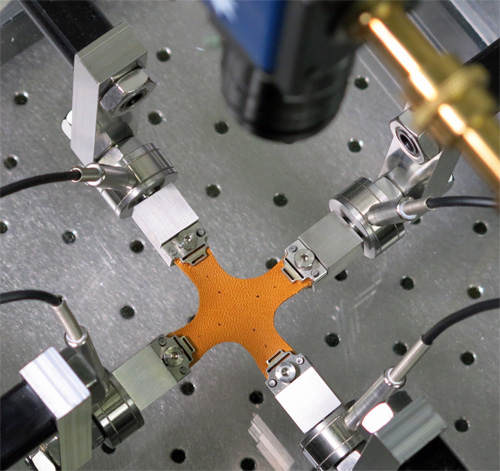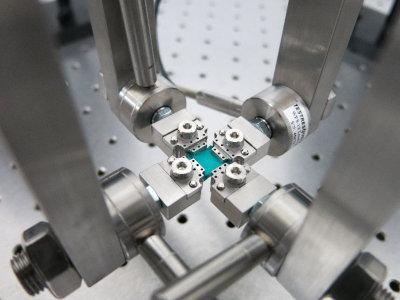
Evaluating the mechanical properties of a material that experiences tensile biaxial states of stress
Planar biaxial tests apply a controlled tension-tension biaxial state of stress and strain to flat specimens to help characterize anisotropic behavior. The data produced provides inputs for constitutive modeling of materials and enables researchers to compare new advanced materials to existing or native materials. They can help assess anisotropy, nonlinear stress-strain relationships and viscoelasticity. Planar biaxial systems can be configured for static, dynamic and fatigue testing applications.
The machines are specially engineered and configured to meet specific customer specimen dimensions and test conditions. Four grips attach the test sample to the machine actuator along each of the flat specimen’s four sides. The machine can be configured with two or four actuators that apply their load to the sample along two primary axes.
What is the Purpose of a Planar Biaxial Test?

Planar biaxial tests determine the mechanical properties of the test sample that experiences tensile biaxial states of stress. The stresses applied to a sample during a planar biaxial test represents the stresses the material will experience during actual service conditions, it can also be used for modeling purposes. Planar biaxial test data is superior to uniaxial test data if the material or end product experiences stress in complex multiaxial configurations during its lifetime. Biaxial tensile strength, compressive strength, flexural strength, fracture properties and fatigue life can all be determined for a material using a planar biaxial test. TestResources’ planar biaxial test systems can perform tension-tension, tension-compression, compression-compression and tension-shear tests.

Tests Made Possible with a Planar Biaxial Tester:
TestResources’ planar biaxial testers can be configured to serve a range of test samples with different load capacity, sample sizes, and sample elongations. Test configurations may include uniaxial tests that can be performed on the same sample. To apply a bi-directional load to a material it must be formed into a thin rectangular shape, also known as cruciform, and applied loads are then configured to be perpendicular to one another. The load applied to the sample may use one or more of the following stress methods: tension, compression, flexure, shear, fracture toughness, and/or fatigue.
Types of Materials Used in Planar Biaxial Tests:
The most common planar biaxial tests are performed upon soft biological tissues, fibrous soft tissues, metal plates and sheet, hard foams, hyperelastic rubber, composite laminates, thin films, fibre reinforced polymer composites, silicone elastomers, textile materials, flexible materials and rigid substrates. Soft biological tissue tests are common in the biomedical industry.
Common Planar Biaxial Test Sample Geometries:
The most common sample geometry is cruciform, with four tabs that can be gripped and connected to the test actuators. Other geometries include inplane tension-tension (IPTT) biaxial test geometry. Regardless of the test sample specifics, grips tend to be made to match the sample attachment options.

Common Applications
- Planar Biaxial Tester for Biological Soft Tissues
- Planar Biaxial Tests of Collagenous Soft Biological Tissues
- Biaxial Tension Tests of Sheet Metal
- Biaxial Fracture Toughness and Crack Growth Tests of Metal
- Planar Biaxial Metals Crack Growth
You Can Pick Your Planar Biaxial Test Machine in 4 Easy Steps
First, select your frame and actuator(Step 1), then complete your system by selecting your controller software(Step 2) and accessories(Step 3). Choose from a wide range of controller software packages, grips, fixtures, chambers, video extensometers and more, are all designed to perform thousands of ASTM, ISO, EN, DIN and JEDEC industry standard test methods.
When you're ready to complete your system, contact us(Step 4), and an application expert will help you optimize your system to your test requirements and budget.
